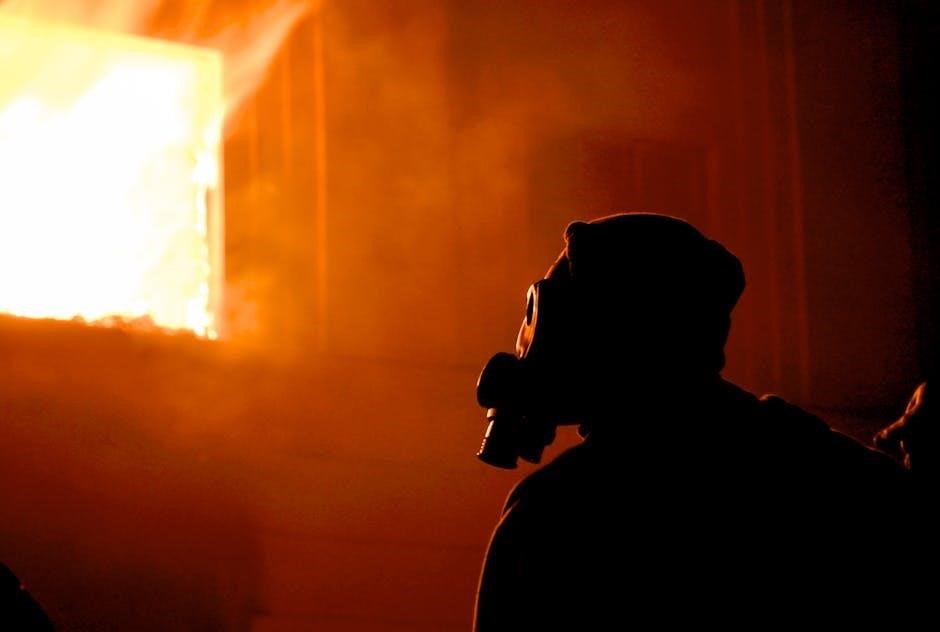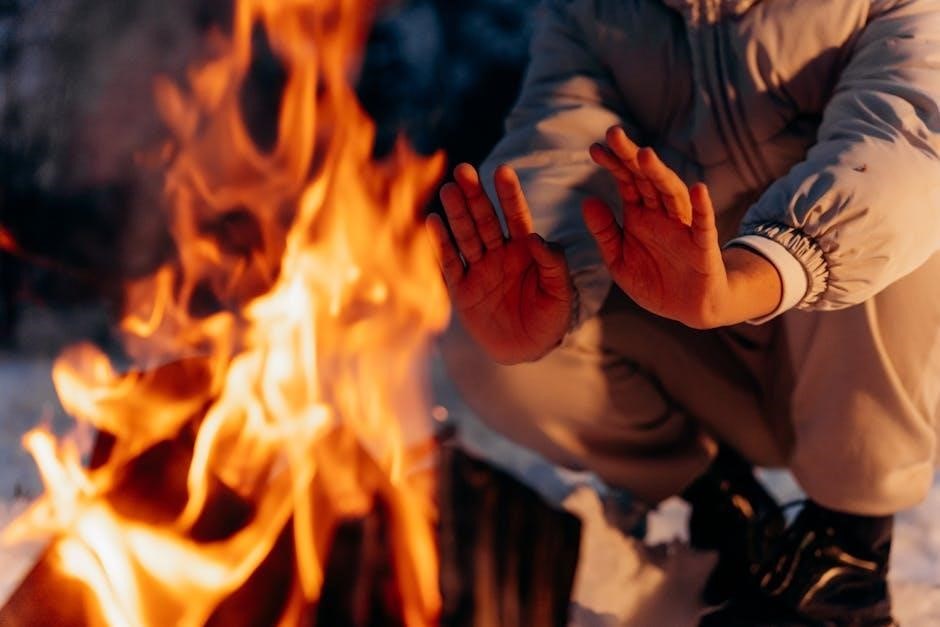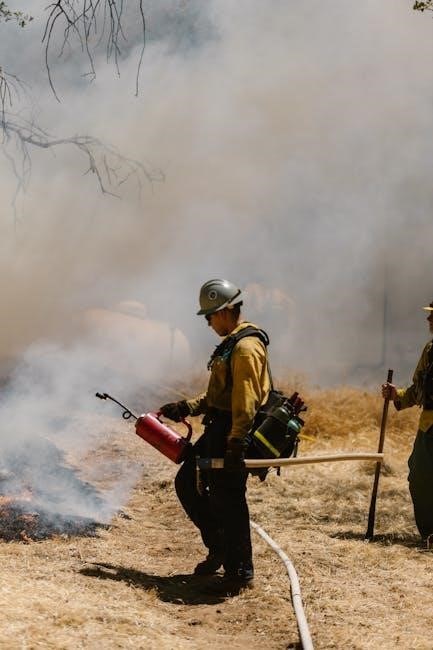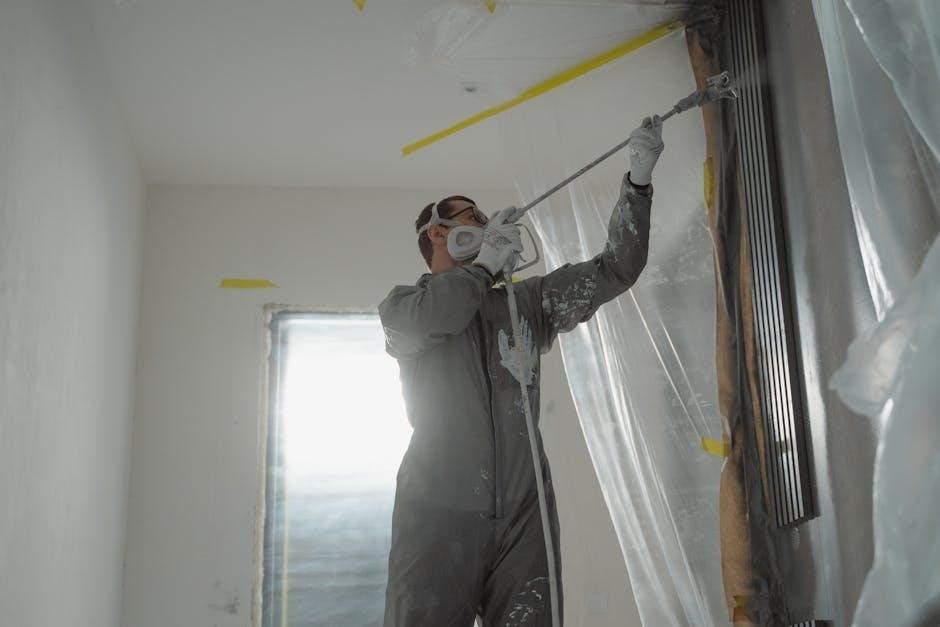Fire safety is a critical life skill, and understanding its principles can mean the difference between life and death. This quiz provides essential knowledge on fire prevention, evacuation procedures, and emergency techniques. It covers key topics like fire causes, extinguisher types, and safety drills, helping individuals and organizations stay prepared. The questions are designed to test awareness and promote practical application, ensuring everyone can act confidently in fire-related situations.
By engaging with these questions, participants can identify gaps in their knowledge and improve their ability to respond effectively during emergencies. Whether at home, school, or work, this quiz serves as a valuable tool for fostering a culture of fire safety and readiness.
1.1 Importance of Fire Safety Education
Fire safety education empowers individuals with knowledge to prevent fires, respond effectively, and protect lives. It fosters awareness of potential hazards, proper use of equipment, and emergency procedures. Regular training and quizzes ensure preparedness, reducing panic during incidents. Educating communities, especially children and employees, builds a culture of safety, minimizing risks and saving lives. Knowledgeable individuals are better equipped to act calmly and responsibly in fire emergencies.
1.2 Benefits of Using Quizzes for Fire Safety Training
Quizzes enhance fire safety training by engaging participants and reinforcing knowledge. They help identify gaps in understanding, ensuring better retention of critical safety practices. Interactive and accessible, quizzes make learning enjoyable while preparing individuals for real-life emergencies. Regular use of fire safety quizzes fosters confidence and readiness, benefiting both home and workplace environments.

Common Causes of Fires
Fires often result from electrical issues, unattended flames, and human error. Key causes include faulty wiring, kitchen mishaps, and improper use of appliances or smoking materials nearby.
2.1 Identifying Potential Fire Hazards
Identifying fire hazards is crucial for preventing accidents. Common risks include unattended candles, overloaded electrical outlets, and improperly stored flammable materials. Regular inspections can help spot these dangers early, allowing for corrective actions like proper storage of chemicals and ensuring all electrical systems are up to code. Awareness and vigilance are key to maintaining a safe environment and reducing fire risks effectively.
2.2 Preventing Fires in Home and Workplace
Preventing fires involves proactive measures like installing smoke detectors, avoiding electrical overload, and storing flammable materials safely. Regular inspections of appliances and wiring are essential to spot potential risks. Ensuring proper ventilation, avoiding clutter, and maintaining fire extinguishers can also mitigate hazards. Educating everyone on fire risks and promoting safe practices fosters a culture of prevention, reducing the likelihood of fires in both home and workplace settings.

Fire Extinguisher Operation and Types
Understanding fire extinguisher types and their operation is crucial for effective fire control. Classes A, B, C, D, and K extinguishers target specific fire sources, from ordinary combustibles to electrical and chemical fires. Proper techniques ensure safe and efficient use, preventing fires from escalating. Regular training and accessibility of extinguishers are key to maintaining fire safety in any setting.
Using the wrong extinguisher can worsen a fire, so identifying the fire class is essential. Always follow the PASS method: Pull the pin, Aim the nozzle, Squeeze the handle, and Sweep the extinguishing agent. Proper maintenance and inspections ensure extinguishers are ready for emergencies.
3.1 Understanding Fire Extinguisher Classes (A, B, C, D, K)
Fire extinguishers are classified based on the types of fires they combat. Class A extinguishers handle ordinary combustibles like paper and wood. Class B is for flammable liquids such as gasoline or oil. Class C is designed for electrical fires, while Class D tackles metal fires. Class K extinguishers are specifically for cooking oils and greases. Each class requires a unique approach to safely and effectively extinguish the fire.
Understanding these classifications ensures the correct extinguisher is used, preventing fire escalation. Using the wrong type can worsen the situation, making it crucial to identify the fire class before acting. Proper training and knowledge of these classes are essential for effective fire management.
3.2 Proper Techniques for Using Fire Extinguishers
Proper techniques for using fire extinguishers are crucial for effective fire management. The PASS method—Pull, Aim, Squeeze, Sweep—provides a systematic approach to extinguishing fires safely.
Pull the safety pin, aim at the base, squeeze to release the agent, and sweep from side to side. Ensure the extinguisher is accessible and know its limitations to prevent fire escalation.
Emergency Procedures During a Fire
Emergency procedures during a fire involve quick action and clear thinking. Establishing an evacuation plan, identifying exits, and staying low to avoid smoke are critical steps. Always prioritize safety and follow designated escape routes to ensure a swift and secure exit during a fire emergency.
4.1 Creating an Evacuation Plan
Creating a fire evacuation plan is crucial for ensuring safety during emergencies. Identify escape routes, designate a meeting point outside, and practice drills regularly. Clearly mark exits and ensure all occupants understand the plan. Tailor it to specific needs, such as mobility challenges, and update it as conditions change. A well-prepared plan reduces confusion and saves lives during a fire.
4.2 Stop, Drop, and Roll Technique
The Stop, Drop, and Roll technique is essential for extinguishing flames on the body. If your clothing catches fire, stop moving, drop to the ground, and roll to smother the flames. This method prevents oxygen from fueling the fire and minimizes burns. Never run, as it spreads the fire. Always cover your face to protect from heat and smoke. Practice this lifesaving technique regularly.
Fire Safety Equipment and Maintenance
Smoke detectors, fire extinguishers, and alarms are vital equipment for early fire detection and suppression. Regular inspections and maintenance ensure they function properly during emergencies, saving lives.
5.1 Smoke Detectors and Alarms
Smoke detectors are crucial for early fire detection, significantly reducing risks in emergencies. Install them on every level of your home and inside sleeping areas. Test them monthly and replace batteries twice a year. Avoid installing in kitchens to prevent false alarms. A functioning smoke detector can save lives by providing critical early warnings. Regular maintenance ensures reliability and effectiveness in case of fire.
5.2 Importance of Regular Fire Safety Inspections
Regular fire safety inspections are vital for identifying and addressing potential hazards. They ensure compliance with safety standards, prevent fire risks, and protect lives and property. Inspections include checking fire extinguishers, smoke detectors, and escape routes. By conducting these checks, organizations and homeowners can maintain a safe environment and respond effectively in emergencies. Consistent inspections foster preparedness and accountability, minimizing fire-related incidents and their consequences.

Fire Prevention Tips and Best Practices
Prevent fires by installing smoke detectors, avoiding electrical overloads, storing flammable materials safely, and conducting regular inspections. These practices minimize risks and ensure a safer environment.
6.1 Safe Use of Electrical Appliances
To prevent fires, avoid overloading outlets with too many devices, as this can cause overheating. Use extension cords wisely and never run them under rugs or near water. Keep electrical appliances away from flammable materials like curtains or paper. Regularly inspect cords and plugs for damage, and replace worn-out items promptly. Always follow manufacturer guidelines for proper usage.
- Avoid using damaged or frayed cords.
- Keep appliances away from water and heat sources.
- Unplug devices when not in use to reduce standby power consumption.
By adhering to these practices, you can significantly reduce the risk of electrical fires and ensure a safer living or working environment.
6.2 Proper Storage of Flammable Materials
Store flammable liquids and materials in well-ventilated, designated areas away from heat sources and open flames. Use approved containers with tight-fitting lids to prevent vapors from escaping. Label containers clearly and keep them away from incompatible substances. Ensure storage areas are cool, dry, and protected from sparks or ignition sources. Always follow safety guidelines to minimize fire risks.
- Keep flammable materials away from direct sunlight.
- Use fire-resistant storage cabinets when possible.
- Adhere to local fire codes and regulations.
Fire Safety Drills and Preparedness
Fire safety drills ensure preparedness by simulating real-life scenarios, teaching evacuation routes, and testing emergency procedures. Regular practice helps individuals respond calmly and efficiently during fires.
7.1 Conducting Fire Safety Drills at Home
Fire safety drills at home are essential for preparing family members to respond quickly and calmly during emergencies. Identify at least two escape routes from each room and designate a safe meeting spot outside the home. Practice the drills every 6 months, involving children and teaching them the Stop, Drop, and Roll technique. Ensure everyone understands the plan and simulates real-life conditions, such as darkness or smoke, to enhance preparedness.
7;2 Training Employees on Fire Emergency Response
Effective fire emergency response training for employees ensures a safe and organized reaction during incidents. Employers should conduct regular drills, educate staff on fire extinguisher use, and establish clear evacuation routes. Training should include identifying fire hazards, understanding alarm systems, and knowing emergency contact procedures. Regular updates on safety protocols and encouraging employee participation in mock drills enhance preparedness and minimize risks in the workplace.
Fire Safety in Specific Settings
Fire safety practices differ across homes, workplaces, and schools based on unique hazards. Tailored strategies ensure preparedness. Regular drills and education are crucial for safety.
8.1 Fire Safety at Home
Home fire safety requires proactive measures to protect families. Installing smoke detectors, securing electrical systems, and storing flammable materials safely are essential. Regular fire drills ensure everyone knows escape routes. Teaching children fire hazards and the Stop, Drop, and Roll technique is vital. Maintaining fire extinguishers and avoiding overloading outlets further reduce risks. Preparedness at home can prevent tragedies.
8.2 Fire Safety in the Workplace
Workplace fire safety involves creating a secure environment through prevention and preparedness. Employers must implement fire prevention programs and inform employees of hazards. Regular fire drills, emergency exit plans, and proper storage of flammable materials are essential. Understanding fire extinguisher types ensures effective response. Training employees on emergency procedures and conducting regular inspections further enhance workplace safety, reducing risks and ensuring compliance with safety standards.
8.3 Fire Safety in Schools
Fire safety in schools is crucial to protect students, staff, and facilities; Schools must conduct regular fire drills, ensuring everyone knows escape routes and assembly points. Educating students on fire hazards and proper evacuation procedures is essential. Schools should maintain functional fire alarms, clear emergency exits, and conduct regular inspections to prevent fire hazards. Training staff and students ensures preparedness and quick response during emergencies, safeguarding the school community.

Advanced Fire Safety Topics
Advanced fire safety topics include understanding fire behavior, managing complex emergencies, and handling specialized fires like electrical or chemical fires. These topics require in-depth knowledge and training to ensure effective response and mitigation, critical for safeguarding lives and property in high-risk environments;
9.1 Understanding Fire Classes and Their Hazards
Fire classes (A, B, C, D, K) are categorized based on fuel sources and hazards. Class A involves ordinary combustibles like wood or paper, while Class B includes flammable liquids. Class C pertains to electrical fires, and Class D involves combustible metals. Class K is for kitchen fires involving cooking oils. Understanding these classes is crucial for selecting the right extinguishing agents and safely managing fire incidents.
9.2 Handling Electrical and Chemical Fires
Electrical fires require caution, as water can conduct electricity, worsening the situation. Use Class C extinguishers for electrical fires. Chemical fires demand specialized agents based on the substance involved. Always evacuate the area, wear protective gear, and avoid using incompatible extinguishing methods. Proper training is essential to handle such hazardous situations safely and effectively, minimizing risks and preventing further damage or injury.
Resources for Fire Safety Quiz Questions and Answers
Reliable PDF materials and online platforms provide comprehensive guides, practice tests, and detailed solutions for fire safety quizzes. These resources are essential for effective study and training preparation.
10.1 Where to Find Reliable Fire Safety PDF Materials
Reliable fire safety PDF materials can be found on websites like hsestudyguide.com, which offers comprehensive guides and practice tests. Educational institutions and fire safety organizations also provide free downloadable resources. Additionally, platforms like Google Drive and Scribd host shared PDFs, while official fire safety organizations like NFPA publish detailed guides. Always verify the credibility of the source to ensure accuracy and relevance.
10.2 Online Platforms for Fire Safety Quizzes
Popular online platforms like Quizlet, SafetyCulture, and hsestudyguide.com offer free fire safety quizzes. These platforms provide interactive tests, multiple-choice questions, and downloadable PDF materials. They cover topics like fire prevention, evacuation procedures, and extinguisher usage. Many also offer customizable tests, making them ideal for both individual learning and workplace training. These resources are accessible and user-friendly, ensuring comprehensive fire safety knowledge.




About the author